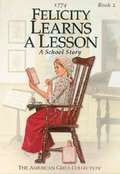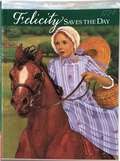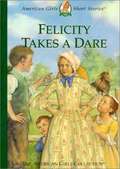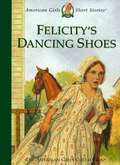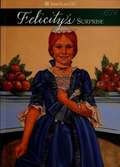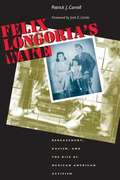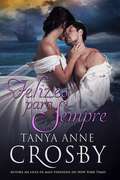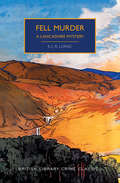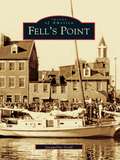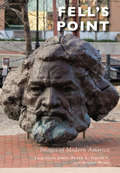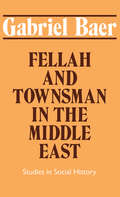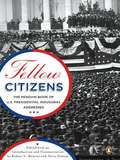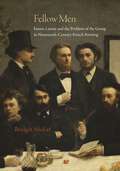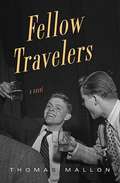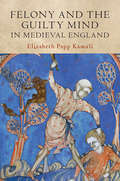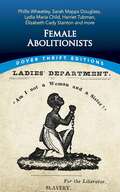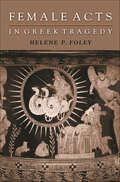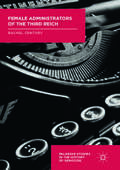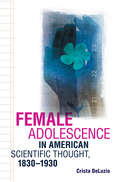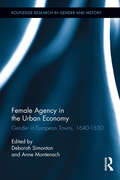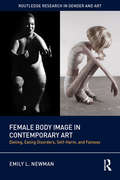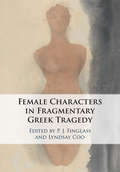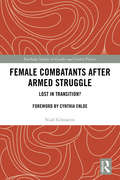- Table View
- List View
Felicity Saves the Day: A Summer Story (American Girls #5)
by Valerie TrippSummer on Grandfather's plantation next to the York River is heaven for Felicity. She can be out of doors all day long-riding horses with Grandfather, playing with Nan and William, and exploring the woods, the fields, and the river's shore. One day Felicity finds a secret note. It is from Ben, her father's apprentice, and it is a cry for help. Ben has broken his apprenticeship agreement with Mr. Merriman and has run away to join George Washington's army. Felicity plunges into a dangerous adventure when she goes to help Ben. She must use all the strength, courage, and wisdom she has to try to save the day.
Felicity's Dancing Shoes (American Girls Short Stories #7)
by Valerie TrippIn colonial Williamsburg, nine-year-old Felicity's dancing skills improve when she changes from wearing clumsy shoes to dainty slippers but ultimately she learns that "Gracefulness is in the foot, not the shoe." Includes information on the education of girls in colonial America, focusing on dance, and presents square dance instructions.
Felicity's Surprise: A Christmas Story (American Girls #3)
by Valerie TrippAll Felicity wants for Christmas is to go to the dancing lesson at the governor's Palace with her friend Elizabeth. Mother works every minute she can spare from Christmas preparations and celebrations to make Felicity a blue gown for this special occasion, then she becomes very ill. <P><P>All thoughts of the gown are forgotten as Felicity nurses her mother and helps care for her brother and sister. Now all Felicity wants for Christmas is for her mother to get well. She's given up on the ball, but Christmas is a time for dreams to come true.
Felix Frankfurter Reminisces
by Felix Frankfurter Harlan B. PhillipsThis volume presents the raw materials for future historians on the variegated aspects of American life, ending with Frankfurter's appointment to the Supreme Court in 1939.
Felix Longoria's Wake
by Patrick J. CarrollDrawing on extensive documentary evidence and interviews with many key figures, including Dr. García and Mrs. Longoria, Carroll convincingly explains why the Longoria incident, though less severe than other acts of discrimination against Mexican Americans, ignited the activism of a whole range of interest groups from Argentina to Minneapolis. By putting Longoria's wake in a national and international context, he also clarifies why it became such a flash point for conflicting understandings of bereavement, nationalism, reason, and emotion between two powerful cultures—Mexicanidad and Americanism.
Felizes Para Sempre
by Tanya Anne Crosby Tânia NezioSophia Vanderwahl, herdeira de uma família de Boston, chegou à conclusão que seu noivo é um namorador da pior espécie. Em busca de vingança, ela se prepara para encontrar o vagabundo a fim de lhe devolver seu anel de noivado, e ela contrata um velho rival dele, para levá-la para Yucatan, no México. Embora desconfiado de seus motivos, Jack MacCauley precisa do dinheiro para financiar sua prrópria expedição. Neste romance marítimo leve e alegre, Jack e Sophie aprendem a confiar um no outro como amantes e como amigos. Crítica publicada na revista Publisher's Weekly: Crosby permanece fiel ao seu estilo neste animado romance do século 19 sobre Sophia Vanderwahl, uma herdeira de Boston que financia o delinquente do seu noivo, Harlan Penn, que viajou para explorar Yucatan e suas nativas. Em busca de vingança, Sophia resolve ir atrás de Harlan para devolver o anel de noivado. Ela contrata Jack MacAuley, um aventureiro arrogante - e antigo rival de Harlan - para levá-la para o México. Embora suspeite dos motivos de Sophia, Jack precisa do dinheiro para financiar sua própria expedição. Jack está convencido de que Sophia está disposta a sabotar seu barco, mas ao longo da estória, as faíscas da raiva se transformam em faíscas de amor. Aos poucos, Jack e Sophia aprendem a confiar um no outro como amantes e amigos. As brincadeiras divertidas das personagens de Crosby manterão os leitores presos a este delicioso romance humorístico. Crítica da RT Book: Mais uma vez, Tanya Anne Crosby presenteia os leitores com uma história de muito amor e carinho. Seu incrível dom para criar um romance alegre e colorido vai encantar o leitor e vai arrastá-lo sobre as ondas de Jack e Sophia numa emocionante viagem de descobertas.
Fell Murder (British Library Crime Classics)
by E.C.R. LoracMystery crime fiction written in the Golden Age of MurderA classic Golden Age mystery from acclaimed author E.C.R. Lorac '...this crime is conditioned by the place. To understand the one you've got to study the other.'The Garths had farmed their fertile acres for generations, and fine land it was with the towering hills of the Lake Country on the far horizon. Here hot-tempered Robert Garth, still hale and hearty at eighty-two, ruled Garthmere Hall with a rod of iron. Until, that is, old Garth was found dead—'dead as mutton'—in the trampled mud of the ancient outhouse.Glowering clouds gather over the dramatic dales and fells as seasoned investigator Chief Inspector Macdonald arrives in the north country. Awaiting him are the reticent Garths and their guarded neighbors of the Lune Valley; and a battle of wits to unearth their murderous secrets.First published in 1944, Fell Murder is a tightly-paced mystery with authentic depictions of its breathtaking locales and Second World War setting. This edition also includes the rare E.C.R. Lorac short story 'The Live Wire'.
Fell's Point (Images of America)
by Jacqueline GreffFell's Point, Baltimore's original deep-water port, was founded in 1726 by William Fell, a shipbuilder from England. The community's shipyards developed the famed Baltimore Clippers; built two of the first ships in the United States Navy, the USS Constellation and the USS Enterprise; and financed the privateers that helped win the War of 1812. In the late 19th century, Baltimore was second only to Ellis Island as an entry port for European immigrants, many of whom initially settled in Fell's Point. When the Great Fire of 1904 swept through Baltimore, Fell's Point was the only historic neighborhood that survived. In the 1960s fight to keep from being demolished for an expressway, Fell's Point became Maryland's first district listed on the National Register of Historic Places. Today in Fell's Point, cultures, lifestyles, and generations mingle in a romantic seaport setting accented by working tugboats, cobblestone streets, tiny brick rowhouses, and a dazzling variety of bars, restaurants, shops, and coffeehouses.
Fell's Point (Images of Modern America)
by Jacqueline Greff Jeffrey Bejma Frank L. Tybush VFell's Point history can be told as a "tale of two cities:" abolitionists and violent secessionists; fire-bombing murderers and community organizers; million-dollar condos and low-income projects; and world champion boxers and a myriad of panhandlers. This dichotomy has created a neighborhood unlike any other in Baltimore. One of the oldest neighborhoods in America, Fell's Point has witnessed much in its 300-plus years. Originally Baltimore's deepwater seaport, Fell's Point's privateers were crucial to winning of the War of 1812. After shipbuilding moved out and waves of immigrants moved through the community, it gradually fell into decline in the first half of the 20th century. In the 1960s, dedicated preservationists began a decade-plus-long battle to defeat city plans to demolish it for a highway. Today, Fell's Point is a thriving, artistic, and eccentric community that welcomes one and all to experience its history, its culture, and its people.
Fellah and Townsman in the Middle East: Studies in Social History
by Gabriel BaerThis volume deals with the history of the "common people" in the Middle East, both villagers and urban dwellers. It investigates some of the characteristic traits of the structure and development of urban and rural society in pre-modern and modern Middle Eastern history.
Fellow Citizens
by Terry Golway Robert V. ReminiThe complete American presidential inaugural addresses featuring historical background by a National Book Award winner A testament to the power of oratory, this stirring and often surprising collection includes all fifty-five United States presidential inaugural addresses, as well as a general introduction and commentary that provides historical context for each speech. Marking pivotal moments in American history, readers will learn: ? How George Washington came to ad-lib ?So help me, God? at the end of his first inaugural address ? Why Thomas Jefferson?s first inaugural address is considered one of the finest ever delivered ? The historical background behind Franklin D. Roosevelt?s ?The only thing we have to fear is fear itself? and John F. Kennedy?s ?Ask not what your country can do for you, ask what you can do for your country.?
Fellow Men: Fantin-Latour and the Problem of the Group in Nineteenth-Century French Painting
by Bridget AlsdorfFocusing on the art of Henri Fantin-Latour (1836-1904) and his colleagues Gustave Courbet, Edgar Degas, Edouard Manet, Frédéric Bazille, and Pierre-Auguste Renoir, Fellow Men argues for the importance of the group as a defining subject of nineteenth-century French painting. Through close readings of some of the most ambitious paintings of the realist and impressionist generation, Bridget Alsdorf offers new insights into how French painters understood the shifting boundaries of their social world, and reveals the fragile masculine bonds that made up the avant-garde.A dedicated realist who veered between extremes of sociability and hermetic isolation, Fantin-Latour painted group dynamics over the course of two decades, from 1864 to 1885. This was a period of dramatic change in French history and art--events like the Paris Commune and the rise and fall of impressionism raised serious doubts about the power of collectivism in art and life. Fantin-Latour's monumental group portraits, and related works by his friends and colleagues from the 1850s through the 1880s, represent varied visions of collective identity and test the limits of association as both a social and an artistic pursuit. By examining the bonds and frictions that animated their social circles, Fantin-Latour and his cohorts developed a new pictorial language for the modern group: one of fragmentation, exclusion, and willful withdrawal into interior space that nonetheless presented individuality as radically relational.
Fellow Travelers: A Novel
by Thomas MallonIt's 1950s Washington, D.C.: a world of bare-knuckled ideology and secret dossiers, dominated by personalities like Richard Nixon, Lyndon Johnson, and Joe McCarthy. Enter Timothy Laughlin, a recent college graduate and devout Catholic eager to join the crusade against Communism. An encounter with a handsome State Department official, Hawkins Fuller, leads to Tim's first job and, after Fuller's advances, his first love affair. As McCarthy mounts a desperate bid for power and internal investigations focus on “sexual subversives” in the government, Tim and Fuller find it ever more dangerous to navigate their double lives. Moving between the diplomatic world of Foggy Bottom and NATO's front line in Europe, Fellow Travelers is a searing historical novel infused with political drama, unexpected humor, and genuine heartbreak.
Felony and the Guilty Mind in Medieval England (Studies in Legal History)
by Elizabeth Papp KamaliThis book explores the role of mens rea, broadly defined as a factor in jury assessments of guilt and innocence from the early thirteenth through the fourteenth century - the first two centuries of the English criminal trial jury. Drawing upon evidence from the plea rolls, but also relying heavily upon non-legal textual sources such as popular literature and guides for confessors, Elizabeth Papp Kamali argues that issues of mind were central to jurors' determinations of whether a particular defendant should be convicted, pardoned, or acquitted outright. Demonstrating that the word 'felony' itself connoted a guilty state of mind, she explores the interplay between social conceptions of guilt and innocence and jury behavior. Furthermore, she reveals a medieval understanding of felony that involved, in its paradigmatic form, three essential elements: an act that was reasoned, was willed in a way not constrained by necessity, and was evil or wicked in its essence.
Female Abolitionists (Dover Thrift Editions)
by Heidi GagnonA Dover Original, this collection of essays, letters, poems, and speeches by the bold women who joined the abolitionist movement of the nineteenth century will educate and inspire all who are interested in this era of American history. The collection includes the work of 26 remarkable women whose efforts, at great risk to their own safety, became instrumental in fighting slavery, including Phillis Wheatley, Sojourner Truth, Mary Prince, Sarah Mapps Douglass, Elizabeth Cady Stanton, Lydia Maria Child, Harriet Tubman, Angelina and Sarah Grimké, and more.
Female Acts in Greek Tragedy (Martin Classical Lectures #15)
by Helene P. FoleyAlthough Classical Athenian ideology did not permit women to exercise legal, economic, and social autonomy, the tragedies of Aeschylus, Sophocles, and Euripides often represent them as influential social and moral forces in their own right. Scholars have struggled to explain this seeming contradiction. Helene Foley shows how Greek tragedy uses gender relations to explore specific issues in the development of the social, political, and intellectual life in the polis. She investigates three central and problematic areas in which tragic heroines act independently of men: death ritual and lamentation, marriage, and the making of significant ethical choices. Her anthropological approach, together with her literary analysis, allows for an unusually rich context in which to understand gender relations in ancient Greece. This book examines, for example, the tragic response to legislation regulating family life that may have begun as early as the sixth century. It also draws upon contemporary studies of virtue ethics and upon feminist reconsiderations of the Western ethical tradition. Foley maintains that by viewing public issues through the lens of the family, tragedy asks whether public and private morality can operate on the same terms. Moreover, the plays use women to represent significant moral alternatives. Tragedy thus exploits, reinforces, and questions cultural clichés about women and gender in a fashion that resonates with contemporary Athenian social and political issues.
Female Administrators of the Third Reich
by Rachel CenturyThis book compares female administrators who specifically chose to serve the Nazi cause in voluntary roles with those who took on such work as a progression of established careers. Under the Nazi regime, secretaries, SS-Helferinnen (female auxiliaries for the SS) and Nachrichtenhelferinnen des Heeres (female auxiliaries for the army) held similar jobs: taking dictation, answering telephones, sending telegrams. Yet their backgrounds and degree of commitment to Nazi ideology differed markedly. The author explores their motivations and what they knew about the true nature of their work. These women had access to information about the administration of the Holocaust and are a relatively untapped resource. Their recollections shed light on the lives, love lives, and work of their superiors, and the tasks that contributed to the displacement, deportation and death of millions. The question of how gender intersected with Nazism, repression, atrocity and genocide forms the conceptual thread of this book.
Female Adolescence in American Scientific Thought, 1830–1930 (New Studies in American Intellectual and Cultural History)
by Crista DeLuzioIn this groundbreaking study, Crista DeLuzio asks how scientific experts conceptualized female adolescence in the nineteenth and early twentieth centuries. Revisiting figures like G. Stanley Hall and Margaret Mead and casting her net across the disciplines of biology, psychology, and anthropology, DeLuzio examines the process by which youthful femininity in America became a contested cultural category.Challenging accepted views that professionals "invented" adolescence during this period to understand the typical experiences of white middle-class boys, DeLuzio shows how early attempts to reconcile that conceptual category with "femininity" not only shaped the social science of young women but also forced child development experts and others to reconsider the idea of adolescence itself. DeLuzio’s provocative work permits a fuller understanding of how adolescence emerged as a "crisis" in female development and offers insight into why female adolescence remains a social and cultural preoccupation even today.
Female Agency in the Urban Economy: Gender in European Towns, 1640-1830 (Routledge Research in Gender and History #14)
by Deborah Simonton Anne MontenachThis innovative new book is overtly and explicitly about female agency in eighteenth-century European towns. However, it positions female activity and decisions unequivocally in an urban world of institutions, laws, regulations, customs and ideologies. Gender politics complicated and shaped the day-to-day experiences of working women. Town rules and customs, as well as police and guilds’ regulations, affected women’s participation in the urban economy: most of the time, the formally recognized and legally accepted power of women – which is an essential component of female agency – was very limited. Yet these chapters draw attention to how women navigated these gendered terrains. As the book demonstrates, "exclusion" is too strong a word for the realities and pragmatism of women’s everyday lives. Frequently guild and corporate regulations were more about situating women and regulating their activities, rather than preventing them from operating in the urban economy. Similarly corporate structures, which were under stress, found flexible strategies to incorporate women who through their own initiative and activities put pressure on the systems. Women could benefit from the contradictions between moral and social unwritten norms and economic regulations, and could take advantage of the tolerance or complicity of urban authorities towards illicit practices. Women with a grasp of their rights and privileges could defend themselves and exploit legal systems with its loopholes and contradictions to achieve economic independence and power.
Female Alliances
by Amanda E. HerbertIn the late seventeenth and early eighteenth centuries, cultural, economic, and political changes, as well as increased geographic mobility, placed strains upon British society. But by cultivating friendships and alliances, women worked to socially cohere Britain and its colonies. In the first book-length historical study of female friendship and alliance for the early modern period, Amanda Herbert draws on a series of interlocking microhistorical studies to demonstrate the vitality and importance of bonds formed between British women in the long eighteenth century. She shows that while these alliances were central to women’s lives, they were also instrumental in building the British Atlantic world.
Female Body Image in Contemporary Art: Dieting, Eating Disorders, Self-Harm, and Fatness (Routledge Research in Gender and Art)
by Emily L. NewmanNumerous contemporary artists, particularly female artists, have chosen to examine the idealization of the female body. In this crucial book, Emily L. Newman focuses on a number of key themes including obesity, anorexia, bulimia, dieting, self-harm, and female body image. Many artists utilize their own bodies in their work, and in the act of trying to critique the diet industry, they also often become complicit, as they strive to lose weight themselves. Making art and engaging eating disorder communities (in real life and online) often work to perpetuate the illnesses of themselves or others. A core group of artists has worked to show bodies that are outside the norm, paralleling the rise of fat activism in the 1990s and 2000s. Interwoven throughout this inclusive study are related interdisciplinary concerns including sociology, popular culture, and feminism.
Female Characters in Fragmentary Greek Tragedy
by P. J. Finglass Lyndsay CooHow were women represented in Greek tragedy? This question lies at the heart of much modern scholarship on ancient drama, yet it has typically been approached using evidence drawn only from the thirty-two tragedies that survive complete - neglecting tragic fragments, especially those recently discovered and often very substantial fragmentary papyri from plays that had been thought lost. Drawing on the latest research on both gender in tragedy and on tragic fragments, the essays in this volume examine this question from a fresh perspective, shedding light on important mythological characters such as Pasiphae, Hypsipyle, and Europa, on themes such as violence, sisterhood, vengeance, and sex, and on the methodology of a discipline which needs to take fragmentary evidence to heart in order to gain a fuller understanding of ancient tragedy. All Greek is translated to ensure wide accessibility.
Female Combatants after Armed Struggle: Lost in Transition? (Routledge Studies in Gender and Global Politics)
by Niall GilmartinThis book stems from a simple ‘feminist curiosity’ that can be succinctly summed up into a single question: what happens to combatant women after the war? Based on in-depth interviews with 40 research participants, mostly former combatants within the Irish Republican Army (IRA), this book offers a critical exploration of republican women and conflict transition in the North of Ireland. Drawing on the feminist theory of a continuum of violence, this book finds that the dichotomous separation of war and peace within conventional approaches represents a gendered fiction. Despite undertaking wartime roles that were empowering, agentic, and subversive, this book finds that the ‘post-conflict moment’ as experienced by female combatants represents not peace and security, but a continuity of gender discrimination, violence, injustice, and insecurity. The experiences and perspectives contained in this book challenge the discursive deployment of terms such as post-conflict, peace, and security, and moreover, shed light on the many forms of post-war activism undertaken by combatant women in pursuit of peace, equality, and security. The book represents an important intervention in the field of gender, political violence, and peace, and more specifically, female combatants and conflict transition. It is analytically significant in its exploration of the ways in which gender operates within non-state military movements emerging from conflict, and will be of interest to students and scholars alike.
